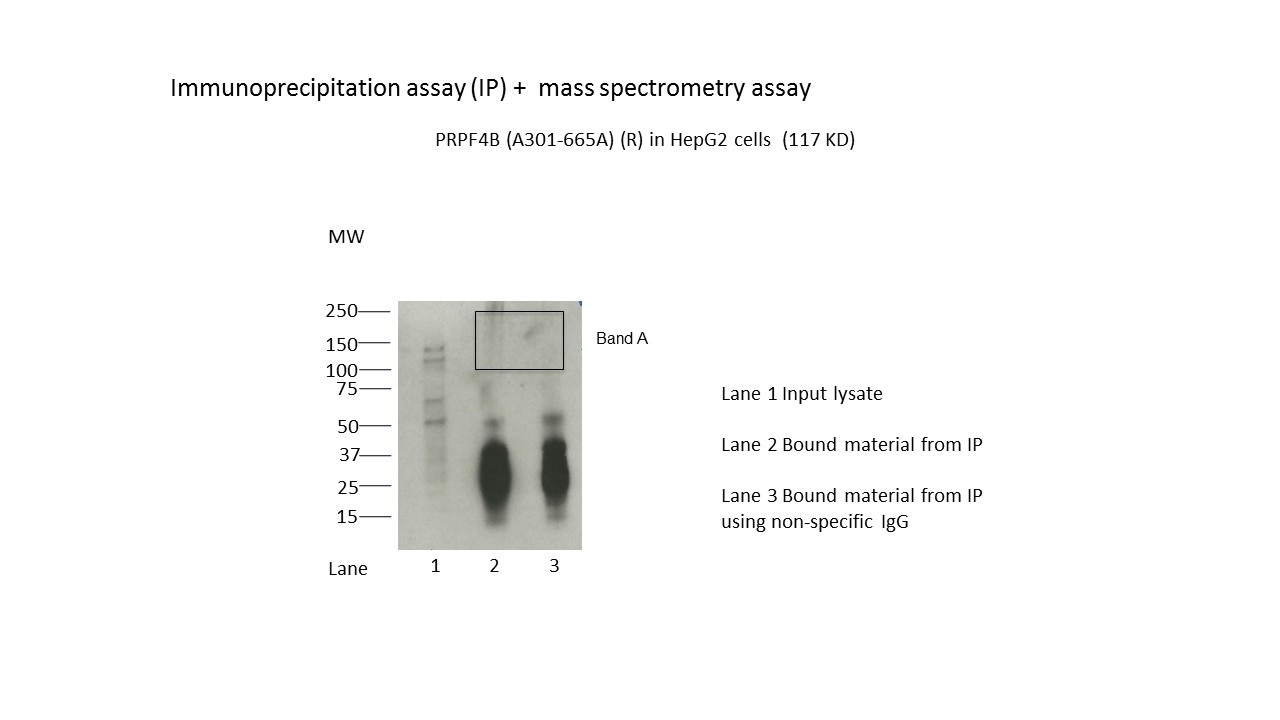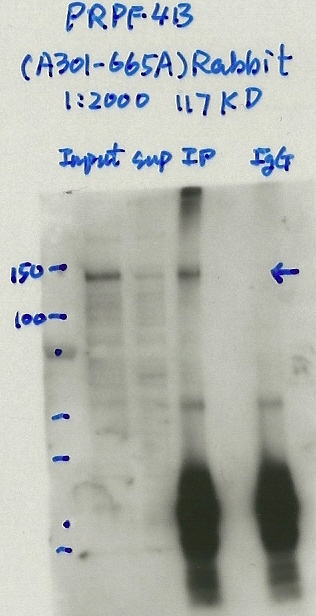ENCAB208ZGL
Antibody against Homo sapiens PRPF4B
Homo sapiens
HepG2
characterized to standards with exemption
- Status
- released
- Source (vendor)
- Bethyl Labs
- Product ID
- A301-665A
- Lot ID
- 1
- Characterized targets
- PRPF4B (Homo sapiens)
- Host
- rabbit
- Clonality
- polyclonal
- Purification
- affinity
- Aliases
- michael-snyder:AS-894
- External resources
Characterizations
PRPF4B (Homo sapiens)
HepG2
compliant
- Caption
- Immunoprecipitation was performed on nuclear extracts from the cell line HepG2 using the antibody A301-665A. Lane 1: input nuclear lysate. Lane 2: material immunoprecipitated with antibody. Lane 3: material immunoprecipitated using control IgG. Marked bands were excised from gel and subjected to analysis by mass spectrometry. Target molecular weight: 116.987.
- Submitted by
- Nathaniel Watson
- Lab
- Michael Snyder, Stanford
- Grant
- U54HG006996
PRPF4B (Homo sapiens)
HepG2
compliant
- Caption
- Immunoprecipitation was performed on nuclear extracts from the cell line: HepG2, using the antibody A301-665A. The blot shows western blot analysis of input, flowthrough, immunoprecipitate and mock immunoprecipitate using IgG.
- Submitted by
- Denis Salins
- Lab
- Michael Snyder, Stanford
- Grant
- U54HG006996
PRPF4B (Homo sapiens)
Method: immunoprecipitation followed by mass spectrometry
exempt from standards
- Caption
- IP followed by mass spectrometry. Briefly, protein was immunoprecipitated from HepG2 nuclear cell lysates using the antibody A301-665A, and the IP fraction was loaded on a 10% polyacrylamide gel (NuPAGEBis-Tris Gel) and separated with an Invitrogen NuPAGE electrophoresis system. The gel was stained by ColloidialCoomassie G-250 stain, gel fragments corresponding to the bands indicated were excised. Then proteins were trypsinized using the in-gel digestion method. Digested proteins were analyzed on an Orbitrap Elite mass spectrometer (Thermo Scientific) by the nanoLC-ESI-MS/MS technique. Peptides were identified by the SEQUEST algorithm and filtered with a high confidence threshold (Peptide false discovery rate < 1%, 2 unique peptides per protein minimum, mass error < 10 ppm).
- Submitter comment
- SNRNP200 involves ATP binding and Poly (A) RNA binding. Both HNRNPUL1 and PRPF4B have interactions with NTRK1 (87KD), http://thebiogrid.org/114416/summary/homo-sapiens/prpf4b.html and http://thebiogrid.org/116281/summary/homo-sapiens/hnrnpul1.html, NTRK1 is not in the same gel slice with HNRNPUL1 and PRPF4B. Both ILF3 and PRPF4B have interactions with ARRB2 (46KD), http://thebiogrid.org/114416/summary/homo-sapiens/prpf4b.html and http://thebiogrid.org/109822/summary/homo-sapiens/ilf3.html, ARRB2 is not in the same gel slice with ILF3 and PRPF4B. Both ILF3 and PRPF4B have interactions with ARRB2 (46KD), http://thebiogrid.org/114416/summary/homo-sapiens/prpf4b.html and http://thebiogrid.org/109822/summary/homo-sapiens/ilf3.html, ARRB2 is not in the same gel slice with ILF3 and PRPF4B. PRPF8 and PRPF4B have interaction, http://thebiogrid.org/114416/summary/homo-sapiens/prpf4b.html. BSCL2 mainly locates in Endoplasmic reticulum membrane, involves lipid metabolism.
- Reviewer comment
- Though ILF3 is ranked higher than PRPF4B but as noted by the submitters, they have interaction partners in common.
- Submitted by
- Nathaniel Watson
- Lab
- Michael Snyder, Stanford
- Grant
- U54HG006996
- Download
- PRPF4B_A301-665A_final.pdf

